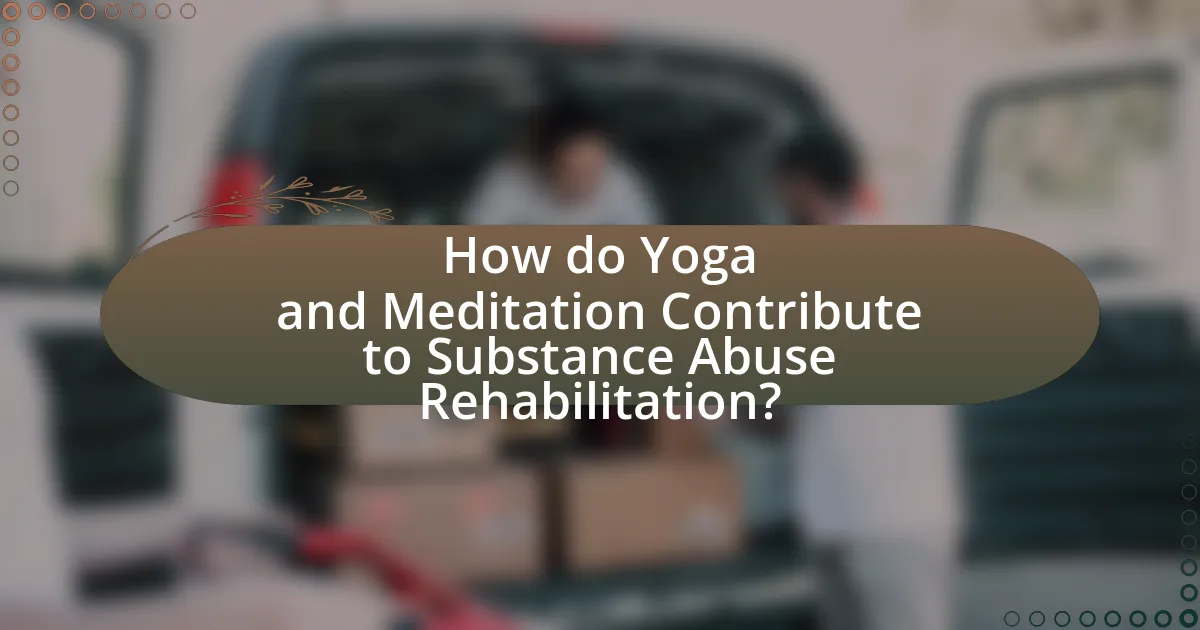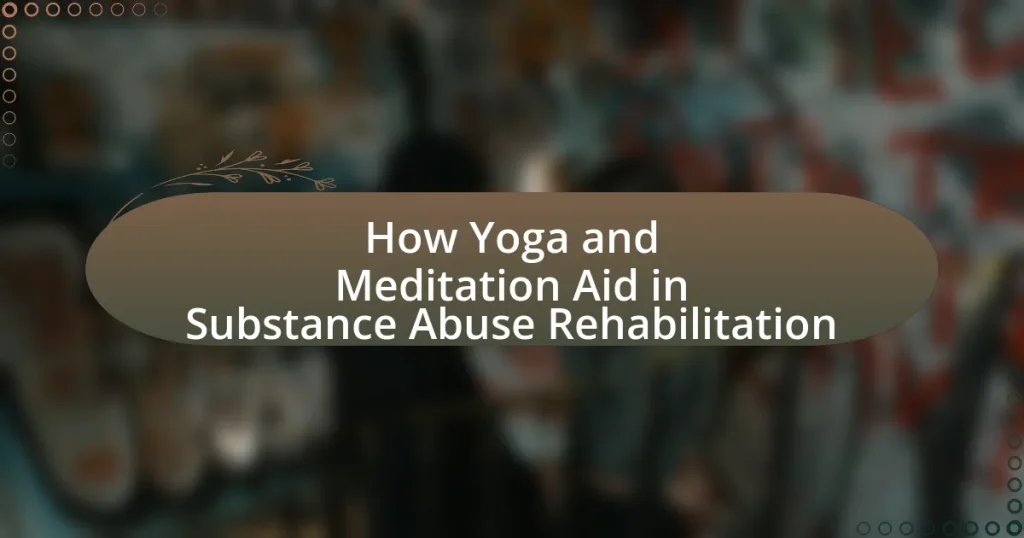The article examines how yoga and meditation contribute to substance abuse rehabilitation by enhancing mindfulness, reducing stress, and improving emotional regulation. It outlines the fundamental principles of these practices, such as breath control and physical postures, and their relationship to mental health and addiction recovery. The article also discusses specific techniques used in yoga and meditation, the importance of mindfulness in managing cravings, and the evidence supporting their effectiveness in rehabilitation. Additionally, it highlights the physical health benefits, the role of community support, and practical steps for individuals to incorporate these practices into their recovery journey.

How do Yoga and Meditation Contribute to Substance Abuse Rehabilitation?
Yoga and meditation contribute to substance abuse rehabilitation by promoting mindfulness, reducing stress, and enhancing emotional regulation. These practices help individuals develop greater self-awareness and coping mechanisms, which are crucial for overcoming addiction. Research indicates that yoga can decrease cravings and withdrawal symptoms, while meditation has been shown to improve mental health outcomes, such as reducing anxiety and depression. A study published in the Journal of Substance Abuse Treatment found that participants who engaged in yoga reported lower levels of substance use and improved psychological well-being. Thus, integrating yoga and meditation into rehabilitation programs can significantly support recovery efforts.
What are the fundamental principles of Yoga and Meditation?
The fundamental principles of Yoga and Meditation include mindfulness, breath control, physical postures, and the cultivation of inner peace. Mindfulness involves being present and aware of thoughts and feelings without judgment, which helps individuals in recovery to manage cravings and emotional triggers. Breath control, or pranayama, regulates the breath to enhance mental clarity and reduce stress, aiding in emotional regulation during rehabilitation. Physical postures, or asanas, promote physical health and flexibility, which can improve overall well-being and resilience in recovery. Lastly, cultivating inner peace through meditation fosters a sense of calm and stability, essential for overcoming the challenges of substance abuse. These principles are supported by research indicating that mindfulness practices can significantly reduce relapse rates and improve emotional regulation in individuals recovering from addiction.
How do these principles relate to mental health and addiction recovery?
The principles of yoga and meditation significantly enhance mental health and addiction recovery by promoting mindfulness, emotional regulation, and stress reduction. Research indicates that mindfulness practices, such as those found in yoga and meditation, can lead to decreased symptoms of anxiety and depression, which are often co-occurring issues in individuals recovering from addiction. A study published in the Journal of Substance Abuse Treatment found that participants who engaged in mindfulness-based interventions reported lower levels of cravings and improved emotional well-being. Furthermore, these practices foster a sense of community and support, which are crucial for sustained recovery, as social support has been shown to improve treatment outcomes.
What specific techniques are used in Yoga and Meditation for rehabilitation?
Yoga and meditation utilize specific techniques such as breath control (pranayama), mindfulness meditation, restorative poses, and guided imagery to aid in rehabilitation. Breath control helps regulate the nervous system, reducing anxiety and promoting relaxation, which is crucial for individuals recovering from substance abuse. Mindfulness meditation enhances self-awareness and emotional regulation, allowing individuals to confront cravings and triggers effectively. Restorative poses facilitate physical relaxation and stress relief, while guided imagery can help individuals visualize positive outcomes and coping strategies. Research indicates that these techniques can significantly improve emotional well-being and reduce relapse rates in rehabilitation settings.
Why is mindfulness important in the context of substance abuse recovery?
Mindfulness is important in the context of substance abuse recovery because it enhances self-awareness and emotional regulation, which are critical for overcoming addiction. By practicing mindfulness, individuals can develop a greater understanding of their thoughts, feelings, and cravings, allowing them to respond to triggers without resorting to substance use. Research indicates that mindfulness-based interventions can significantly reduce relapse rates; for instance, a study published in the Journal of Substance Abuse Treatment found that participants who engaged in mindfulness practices reported lower levels of substance use and improved coping strategies. This evidence underscores the effectiveness of mindfulness in supporting long-term recovery from substance abuse.
How does mindfulness practice enhance self-awareness in recovering individuals?
Mindfulness practice enhances self-awareness in recovering individuals by promoting present-moment awareness and non-judgmental observation of thoughts and feelings. This practice allows individuals to recognize triggers and cravings associated with substance use, facilitating a deeper understanding of their emotional and behavioral patterns. Research indicates that mindfulness can lead to significant reductions in relapse rates; for instance, a study published in the journal “Substance Abuse” found that participants who engaged in mindfulness-based interventions reported improved self-regulation and emotional resilience, which are critical for maintaining sobriety.
What role does mindfulness play in managing cravings and triggers?
Mindfulness plays a crucial role in managing cravings and triggers by enhancing self-awareness and emotional regulation. Through mindfulness practices, individuals learn to observe their thoughts and feelings without judgment, which helps them recognize cravings as temporary sensations rather than immediate demands. Research indicates that mindfulness can reduce the intensity of cravings and the likelihood of relapse in substance abuse situations. A study published in the journal “Substance Use & Misuse” found that participants who engaged in mindfulness-based interventions reported significantly lower levels of craving and improved coping strategies compared to those who did not. This evidence supports the effectiveness of mindfulness in helping individuals navigate the challenges of cravings and triggers during rehabilitation.
What evidence supports the effectiveness of Yoga and Meditation in rehabilitation?
Yoga and meditation have been shown to be effective in rehabilitation, particularly in substance abuse recovery. Research indicates that these practices can reduce stress, anxiety, and cravings, which are critical factors in recovery. A study published in the Journal of Substance Abuse Treatment found that participants who engaged in yoga experienced significant reductions in substance use and improved emotional regulation. Additionally, a meta-analysis in the Journal of Alternative and Complementary Medicine highlighted that mindfulness meditation significantly decreased relapse rates among individuals recovering from addiction. These findings underscore the role of yoga and meditation as complementary therapies in enhancing rehabilitation outcomes.
What studies have been conducted on Yoga and Meditation for addiction treatment?
Numerous studies have been conducted on the efficacy of yoga and meditation in addiction treatment. One significant study published in the Journal of Substance Abuse Treatment by Brown et al. (2015) found that participants who engaged in yoga experienced reduced cravings and improved emotional regulation. Another research conducted by Khalsa et al. (2015) demonstrated that mindfulness meditation significantly decreased substance use and improved psychological well-being among individuals in recovery. Additionally, a meta-analysis by Cramer et al. (2013) highlighted that yoga interventions led to significant reductions in substance use and improved mental health outcomes across various populations. These studies collectively support the integration of yoga and meditation as effective complementary therapies in addiction treatment programs.
How do the outcomes of these practices compare to traditional rehabilitation methods?
The outcomes of yoga and meditation practices in substance abuse rehabilitation often show greater effectiveness compared to traditional rehabilitation methods. Research indicates that individuals who engage in yoga and meditation experience reduced cravings, lower stress levels, and improved emotional regulation, which are critical factors in recovery. A study published in the Journal of Substance Abuse Treatment found that participants who practiced yoga reported a 50% reduction in substance use compared to those undergoing standard treatment alone. Additionally, yoga and meditation enhance mindfulness, which has been linked to better coping strategies and relapse prevention. These practices not only address the physical aspects of addiction but also promote mental and emotional well-being, leading to more sustainable recovery outcomes.
How can Yoga and Meditation be integrated into rehabilitation programs?
Yoga and meditation can be integrated into rehabilitation programs by incorporating structured sessions that focus on mindfulness, physical postures, and breathing techniques. These practices enhance emotional regulation, reduce stress, and improve overall mental health, which are crucial for individuals recovering from substance abuse. Research indicates that participants in rehabilitation programs that include yoga and meditation report lower levels of anxiety and depression, leading to improved treatment outcomes. A study published in the Journal of Substance Abuse Treatment found that yoga significantly reduced cravings and withdrawal symptoms in individuals recovering from addiction, demonstrating its effectiveness as a complementary therapeutic approach.
What challenges might arise when incorporating these practices into treatment?
Incorporating yoga and meditation into substance abuse rehabilitation may present challenges such as resistance from patients, lack of trained instructors, and integration with existing treatment protocols. Patients may resist these practices due to skepticism about their effectiveness or discomfort with new approaches, which can hinder participation and outcomes. Additionally, the scarcity of qualified instructors trained in both yoga and addiction recovery can limit the availability of these practices in treatment settings. Furthermore, integrating yoga and meditation into established treatment protocols requires careful coordination to ensure that these practices complement rather than conflict with traditional therapeutic methods, which can complicate implementation.

What specific benefits do Yoga and Meditation provide in substance abuse rehabilitation?
Yoga and meditation provide significant benefits in substance abuse rehabilitation by enhancing emotional regulation, reducing stress, and promoting mindfulness. These practices help individuals develop coping strategies that are essential for recovery. Research indicates that yoga can decrease cravings and improve overall mental health, as evidenced by a study published in the Journal of Substance Abuse Treatment, which found that participants who engaged in yoga reported lower levels of anxiety and depression. Additionally, meditation fosters a greater awareness of thoughts and feelings, allowing individuals to manage triggers more effectively. This combination of emotional and psychological support is crucial for sustaining long-term recovery from substance abuse.
How do these practices improve emotional regulation?
Yoga and meditation improve emotional regulation by enhancing self-awareness and promoting mindfulness. These practices encourage individuals to observe their thoughts and feelings without judgment, which helps in recognizing emotional triggers. Research indicates that mindfulness meditation can lead to increased activity in brain regions associated with emotional regulation, such as the prefrontal cortex, thereby improving the ability to manage emotions effectively. Additionally, yoga incorporates physical movement and breath control, which can reduce stress and anxiety levels, further aiding in emotional stability. Studies have shown that participants in yoga and meditation programs report lower levels of emotional distress and improved coping strategies, validating their effectiveness in enhancing emotional regulation.
What techniques are effective for enhancing emotional stability?
Techniques effective for enhancing emotional stability include mindfulness meditation, yoga, and cognitive-behavioral strategies. Mindfulness meditation promotes awareness and acceptance of emotions, which can reduce anxiety and improve emotional regulation. Research indicates that regular mindfulness practice can lead to significant improvements in emotional well-being, as evidenced by a study published in the Journal of Happiness Studies, which found that participants experienced reduced stress and increased emotional resilience. Yoga, through its combination of physical postures, breath control, and meditation, has been shown to decrease symptoms of anxiety and depression, contributing to greater emotional stability. A meta-analysis in the Journal of Clinical Psychology highlighted that yoga practice significantly enhances mood and emotional regulation. Cognitive-behavioral strategies, such as reframing negative thoughts and developing coping mechanisms, are also effective in fostering emotional stability, as they empower individuals to manage their emotional responses more effectively.
How does improved emotional regulation impact recovery success?
Improved emotional regulation significantly enhances recovery success in substance abuse rehabilitation. Individuals who effectively manage their emotions are better equipped to cope with stressors and triggers that may lead to relapse. Research indicates that emotional regulation skills, such as mindfulness and cognitive restructuring, can reduce cravings and improve overall mental health, thereby increasing the likelihood of sustained recovery. For instance, a study published in the Journal of Substance Abuse Treatment found that participants who practiced mindfulness-based interventions reported lower levels of anxiety and depression, which are critical factors in maintaining sobriety.
In what ways do Yoga and Meditation promote physical health during recovery?
Yoga and meditation promote physical health during recovery by enhancing bodily awareness, reducing stress, and improving overall physical fitness. These practices facilitate the release of tension in the body, which can alleviate physical symptoms associated with withdrawal and recovery. Research indicates that yoga can improve flexibility, strength, and balance, contributing to better physical health outcomes. A study published in the Journal of Substance Abuse Treatment found that participants who engaged in yoga reported significant reductions in stress and anxiety levels, which are critical factors in recovery. Additionally, meditation has been shown to lower cortisol levels, thereby reducing stress and promoting a sense of calm, which is essential for healing. Together, these practices support the physical and mental aspects of recovery, fostering a holistic approach to rehabilitation.
What physical benefits can be expected from regular practice?
Regular practice of yoga and meditation can lead to improved physical health, including enhanced flexibility, increased strength, and better cardiovascular function. Studies indicate that yoga can increase flexibility by up to 35% in participants over a few months, while also improving muscle strength and endurance. Additionally, research published in the Journal of Clinical Psychology shows that meditation can lower blood pressure and reduce heart rate, contributing to overall cardiovascular health. These physical benefits support the rehabilitation process by promoting a healthier body, which is crucial for recovery from substance abuse.
How does physical health influence overall recovery outcomes?
Physical health significantly influences overall recovery outcomes by enhancing the body’s ability to heal and cope with stress. Individuals with better physical health often experience improved immune function, increased energy levels, and greater resilience, which are critical during the recovery process. Research indicates that physical fitness can lead to better mental health outcomes, as regular exercise releases endorphins that reduce stress and anxiety, factors that are crucial in substance abuse rehabilitation. For instance, a study published in the Journal of Substance Abuse Treatment found that participants who engaged in regular physical activity reported lower levels of substance use and higher rates of recovery success. Thus, maintaining good physical health is essential for achieving favorable recovery outcomes in substance abuse rehabilitation.
How do Yoga and Meditation foster community and support among individuals in recovery?
Yoga and meditation foster community and support among individuals in recovery by creating shared experiences that promote connection and understanding. These practices encourage participants to engage in group sessions, which facilitate social interaction and the development of supportive relationships. Research indicates that group yoga and meditation can enhance feelings of belonging and reduce feelings of isolation, which are critical for individuals in recovery. A study published in the Journal of Substance Abuse Treatment found that participants in yoga programs reported increased social support and improved emotional well-being, highlighting the role of these practices in building a supportive community.
What role does group practice play in building connections?
Group practice plays a crucial role in building connections by fostering a sense of community and shared experience among participants. In the context of yoga and meditation for substance abuse rehabilitation, group practice encourages individuals to engage with one another, share their struggles, and support each other’s recovery journeys. Research indicates that social support is a significant factor in successful rehabilitation outcomes, as it helps reduce feelings of isolation and promotes accountability. For instance, a study published in the Journal of Substance Abuse Treatment found that group therapy significantly enhances emotional bonding and connection, which are vital for long-term recovery.
How can community support enhance the rehabilitation experience?
Community support enhances the rehabilitation experience by providing emotional encouragement, accountability, and a sense of belonging. Individuals in recovery often face feelings of isolation; community support mitigates this by fostering connections with others who understand their struggles. Research indicates that social support can significantly improve treatment outcomes, with studies showing that individuals with strong community ties are more likely to maintain sobriety and engage in healthy behaviors. For example, a study published in the Journal of Substance Abuse Treatment found that participants who reported higher levels of social support had lower rates of relapse. This evidence underscores the critical role that community plays in reinforcing positive changes during the rehabilitation process.

What practical steps can individuals take to incorporate Yoga and Meditation into their recovery journey?
Individuals can incorporate Yoga and Meditation into their recovery journey by establishing a consistent practice, starting with short sessions and gradually increasing duration. Engaging in yoga classes specifically designed for recovery can provide structure and community support, while guided meditation apps can help individuals focus and develop mindfulness skills. Research indicates that regular yoga practice can reduce stress and anxiety, which are common triggers for substance use, and a study published in the Journal of Substance Abuse Treatment found that participants who practiced yoga reported lower levels of cravings and improved emotional regulation. Additionally, creating a dedicated space for practice at home can enhance commitment and provide a calming environment conducive to recovery.
What are some beginner-friendly Yoga and Meditation practices for those in recovery?
Beginner-friendly yoga and meditation practices for those in recovery include gentle yoga styles such as Hatha and Yin yoga, as well as mindfulness meditation techniques. Hatha yoga focuses on basic postures and breathing exercises, promoting relaxation and physical awareness, which can help individuals in recovery manage stress and anxiety. Yin yoga involves holding poses for longer durations, enhancing flexibility and encouraging introspection, beneficial for emotional healing. Mindfulness meditation, which emphasizes present-moment awareness, can reduce cravings and improve emotional regulation, making it a valuable tool in recovery. Research indicates that these practices can lead to improved mental health outcomes, as evidenced by a study published in the Journal of Substance Abuse Treatment, which found that participants who engaged in yoga and meditation reported lower levels of anxiety and depression.
How can individuals create a consistent practice routine?
Individuals can create a consistent practice routine by establishing a specific schedule and setting clear goals. Consistency is enhanced when individuals allocate dedicated time slots for practice, such as daily sessions at the same time, which helps in forming a habit. Research indicates that habits are formed through repetition and reinforcement; for instance, a study published in the European Journal of Social Psychology found that it takes an average of 66 days for a new behavior to become automatic. Additionally, tracking progress and reflecting on experiences can further solidify commitment to the routine, as self-monitoring has been shown to improve adherence to practice schedules.
What resources are available for learning Yoga and Meditation techniques?
Resources available for learning Yoga and Meditation techniques include online platforms, books, and local classes. Websites like Yoga Journal and Headspace offer comprehensive guides and instructional videos for various skill levels. Books such as “The Heart of Yoga” by T.K.V. Desikachar provide in-depth knowledge on yoga philosophy and practice. Additionally, local community centers and yoga studios often host classes that cater to beginners and advanced practitioners alike, facilitating hands-on learning and guidance from experienced instructors. These resources collectively support individuals in integrating yoga and meditation into their rehabilitation process.
What tips can enhance the effectiveness of Yoga and Meditation in rehabilitation?
Incorporating structured routines, focusing on breath control, and integrating mindfulness techniques can significantly enhance the effectiveness of Yoga and Meditation in rehabilitation. Structured routines provide consistency, which is crucial for individuals recovering from substance abuse, as it helps establish a sense of stability and predictability. Breath control techniques, such as pranayama, have been shown to reduce anxiety and improve emotional regulation, which are vital during the recovery process. Mindfulness practices, including body scans and meditation, promote self-awareness and help individuals recognize triggers and cravings, facilitating better coping strategies. Research indicates that these practices can lead to improved mental health outcomes, as evidenced by a study published in the Journal of Substance Abuse Treatment, which found that participants who engaged in mindfulness-based interventions reported lower levels of substance use and improved psychological well-being.
How can individuals stay motivated in their practice?
Individuals can stay motivated in their practice by setting clear, achievable goals and tracking their progress. Research indicates that goal-setting enhances motivation by providing direction and a sense of accomplishment, which is crucial in the context of rehabilitation. For instance, a study published in the Journal of Substance Abuse Treatment found that individuals who set specific goals related to their recovery were more likely to maintain their commitment to treatment and practice. Additionally, incorporating mindfulness techniques from yoga and meditation can help individuals stay present and focused, reducing anxiety and increasing motivation to engage in their practice consistently.
What common pitfalls should be avoided during the recovery process?
Common pitfalls to avoid during the recovery process include neglecting self-care, underestimating the importance of support systems, and failing to set realistic goals. Neglecting self-care can lead to burnout and relapse, as individuals may overlook their physical and mental health needs. Underestimating the importance of support systems, such as therapy or support groups, can result in isolation, which is detrimental to recovery. Additionally, failing to set realistic goals can create frustration and disappointment, making it harder to maintain motivation. Research indicates that structured support and realistic expectations significantly enhance recovery outcomes, emphasizing the need to avoid these pitfalls.
